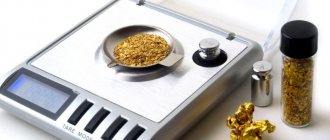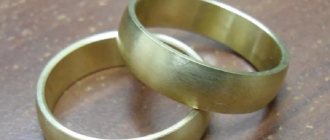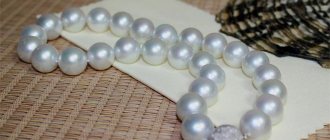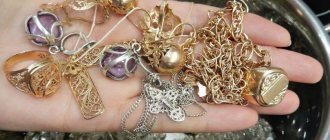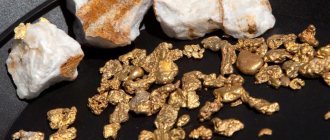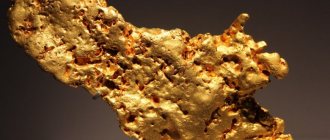There are times when a piece of jewelry doesn't fit or you just don't like the design. In this case, melting gold will help. Then you can make a decoration that suits your taste and size, which will really please the eye.
It is worth noting that melted products can be worn for quite a long time. There should be no problems with this if the master turns out to be truly skillful. Therefore, you should choose a specialist carefully. Moreover, you need to take into account that not all masters undertake such work. And some people ask for a lot of money for such a service, so it’s more profitable to sell the jewelry you don’t like and just buy a new one with an additional payment.
It is profitable to melt gold. For example, at home you may accumulate several one-of-a-kind earrings, a torn bracelet and several old grandmother’s rings. All this can be turned into beautiful earrings, a chain with a pendant, or something else that will definitely please the owner’s eye.
What is white gold really?
Rhodium metallization: creating white gold from yellow
Rhodium is a rare metal that is very resistant to corrosion. We already know that white gold is plated with rhodium, but this metal can also be used to plate yellow gold to make it appear white. If you take your gold ring or other item to a jeweler, he will be able to plate it with rhodium for a fee.
Is it always easy to turn yellow gold into white gold? In reality, rhodium plating does not always work out as intended.
Problems with rhodium metallization during product processing
The biggest problem with rhodium plating is that you never know if the metal will stick to the surface of the piece. Whether a piece of jewelry can be plated with rhodium largely depends on the exact content of the alloy used in its manufacture. Some yellow gold alloys simply don't work out, and it's hard to tell in advance how successful the plating process will be.
Another problem is that the plating may not penetrate into the crevices of the jewelry. In this case, the product must be plated again. This problem is amplified if the jewelry has an intricate design with embellishments or different shapes that are resistant to plating.
How long does rhodium last on a product?
Like any coating, rhodium plating does not last forever. The metal softens over time, and the more often you wear your jewelry, the faster the rhodium layer will come off.
Additionally, each time your jewelry is professionally polished, the top layer is gradually removed by the polishing tools and the rhodium wears off, but you can always replate your jewelry with this metal.
Click here to view our collection of popular white gold jewelry.
Can rhodium plating be removed?
What if you don't like the look of your newly whitewashed gold? Is it possible to get rid of rhodium metallization? The answer is "Yes". You can ask a jeweler to remove the rhodium layer by polishing, then your jewelry will turn yellow again.
It doesn't matter whether you prefer yellow or white gold. Rhodium plating can be very useful if you want to see how your ring's gem would look in white gold but don't want to have to re-set it.
You can also cover only the teeth of your ring with metal. This is a good idea when you have a white diamond in a setting and you don't want the yellow prongs to ruin the color of the stone.
Source
Gold Refining: Centralized Method
Another method of gold smelting is called centralized. In this case, not one or two pieces of jewelry are melted, but a certain amount of gold scrap from various products with different purity.
Here the finished alloy will have a sample different from the starting materials. The sample is determined using a special chemical analysis after the metal has cooled. This gold remelting is not done using a heating pad - special electric furnaces with electrodes are used. Also, during melting, graphite powder is used at the output to produce purer metal. There are also high-frequency furnaces for melting gold, but it is advisable to use them on an industrial scale.
White and regular yellow gold: which is more expensive, better and how they differ
Gold is a noble metal and relevant at all times. Depending on the weight of the jewelry and the complexity of its manufacture, everyone can choose a product that suits their pocket. But if before the classic yellow gold was the most common, now its various shades have taken their place on the market - white, pink, red, green, blue, black.
White gold is rightfully considered the most popular and valuable
. It will especially appeal to those who do not like yellow metal, but are considering purchasing gold jewelry. Such products are elegant, sophisticated and look great in combination with precious stones.
If color is not the primary criterion, then when choosing jewelry made of yellow or white gold, you need to keep in mind that their properties are somewhat different
. Each option has both its advantages and disadvantages.
Process duration
It all depends on several indicators. First of all, the test plays a big role. The higher it is, the faster the melting process will occur. Much depends on the type of decoration. Larger, simpler rings will melt much faster. If we are talking about complex weaving or a product with stones, then you will have to wait, since the procedure will be more difficult for the master.
Manufacturing time may also vary. It all depends on the complexity. It will take some time to place the sample. But on average, this process takes about a month. When receiving your order, be sure to pay attention to the weight and sample. The product must be accompanied by a receipt signed by the manufacturer with a detailed description of the jewelry.
What is the difference between white gold and yellow gold?
Gold in its pure form has a bright yellow color, it is soft and easily deformed. Therefore, it is not used to make jewelry, but mixed with other metals - alloys
.
The composition and ratio of alloying elements in a gold alloy determine its color and other physical properties.
Thus, the differences between white gold and ordinary yellow gold are associated with the introduction of different components into their alloys. In most cases:
Sometimes alloys characteristic of yellow alloys are used for white alloys, and vice versa, to obtain the desired properties and shades of the metal.
To better understand the difference between these two types of gold, it is necessary to take a closer look at their characteristics.
How is the color of the alloy obtained?
The color of the yellow alloy is determined by the ratio of copper and silver content
in its composition. For example, the most common 585-carat gold has a bright and rich yellow color with almost the same content of alloying components - 22.75% Cu and 18.75% Ag. The less copper, the paler the shade. A further increase in its amount will lead to reddening of the material.
The white alloy is obtained by “bleaching” gold with an alloying metal
:
White gold alloyed with palladium or platinum is considered noble.
Both yellow and white gold can have zinc
. It helps to brighten the alloy.
Mechanical properties of alloys
To increase the hardness of yellow gold
use
copper
.
However, a large amount of it leads to a deterioration in the anti-corrosion properties of the alloy. To eliminate this drawback, silver
. It increases the ductility of the material and its resistance to corrosion.
As for white gold
, the addition of nickel, palladium or platinum to the composition makes it highly anti-corrosion.
Nickel
gives the alloy hardness and strength; such material is well polished.
But the compound with palladium
is softer. Angular, intricately ornate products from such an alloy are rarely made, since over time the corners can be smoothed out and lose their original appearance. However, such a material has good ductility.
It is believed that white gold wears better than yellow gold. It is harder and scratches less.
Platinum
makes the gold alloy not only harder, but also more elastic. This property is useful in the manufacture of complex jewelry and for the subsequent insertion of precious stones.
Possible allergic reactions
Gold itself is absolutely harmless to humans. It does not enter into chemical reactions with other substances. Another thing is metal alloys.
Nickel is the most common cause of allergic reactions.
, often found in white gold. That is why the use of such an alloy has been prohibited in Europe since 2000. It is, of course, advisable to choose products without this metal in the composition. As an option, you can consider jewelry not of 585 gold standard, but of 750 gold. If nickel does get into such an alloy, it is in much smaller quantities.
Copper is also an allergenic ligature.
and less commonly
zinc
. If gold jewelry, for example, a ring or chain, has darkened the skin, then this is a consequence of copper oxidation. This effect can appear both when the metal interacts with the external environment and with human skin (reaction to sweat). In such cases, it is also recommended to choose products made of 18-carat yellow gold, which contains less alloy.
The appearance of allergic reactions is now relevant for many people, so you should always pay attention to the composition of the gold alloy.
When purchasing jewelry with a high standard, you must keep in mind that a large amount of gold makes them soft and they are susceptible to external loads. Such products are more easily scratched and deformed, so you need to wear them with caution.
Allergies to nickel, which is used in large quantities in inexpensive jewelry, are much more common than to copper. Therefore, it is believed that from this point of view, white gold is more dangerous than yellow gold.
A little history
The fact that precious metal can be given a wide range of shades has been known since ancient times. Colored gold was first used in the jewelry industry in the 19th century. This happened in connection with the discovery of new noble metals - osmium, rhodium and palladium. At the same time, experiments began to be carried out to introduce them into precious alloys. Despite the fact that the components were known, the technology of joining metals was kept in the strictest confidence by jewelers.
Already at this time it became clear that the alloy in the alloy affects the color and strength of the products, but not their quality. The impurity content should not exceed the permissible 0.17%. Therefore, at present, regardless of what metal was used as a master alloy, the general gold-bearing alloy is considered precious.
What is more expensive: regular yellow gold or white gold?
With the same amount of gold in yellow and white alloys, their price will depend on the type of alloying elements and their percentage
.
Copper, nickel and zinc are base, inexpensive metals. In this case, the cost of yellow and white alloy will be approximately the same.
The price of white gold with the addition of palladium will be higher than with nickel. And finally, the most expensive alloy is with platinum. These are noble metals that are not cheap in themselves, especially platinum. In addition, working with these materials is more difficult than with conventional metals.
Due to the harmfulness of nickel, jewelry manufacturers are increasingly alloying gold with palladium or platinum, thereby increasing the cost of the white alloy.
How gold melts
This procedure is considered very complicated, so not everyone undertakes such work. The process of melting gold is labor-intensive and can take up to one month. To begin with, the master thoroughly cleans the product. There should not be a single particle of dust left on it that could negatively affect the condition of the new jewelry.
After the gold element that is to be melted down has been thoroughly cleaned, it is moved into a special container and placed in the furnace. Here the metal is heated to a temperature of 1064°C. This is the mark at which gold can be melted.
The prepared metal is poured into the mold, the workpiece should harden well. This takes a lot of time. Next, jewelry will be made from it according to a layout previously discussed with the customer. These can be earrings, chains, bracelets, pendants, etc.
Is it possible to make white gold from yellow gold?
There is an inexpensive way to make white gold from ordinary yellow gold - rhodium plating
. It consists of applying a very thin (several microns) layer of rhodium to the surface of the product.
Rhodium is a noble metal that belongs to the platinum group and is white in color. The decoration treated in this way acquires an ideal coating.
– smooth, shiny, without yellowness and other additional shades.
In addition, rhodium strengthens and strengthens the product. However, the coating has one significant drawback
- fragility. Over time, upon contact with the skin, the rhodium layer wears off, exposing the original alloy. This product loses its attractive appearance.
Source


